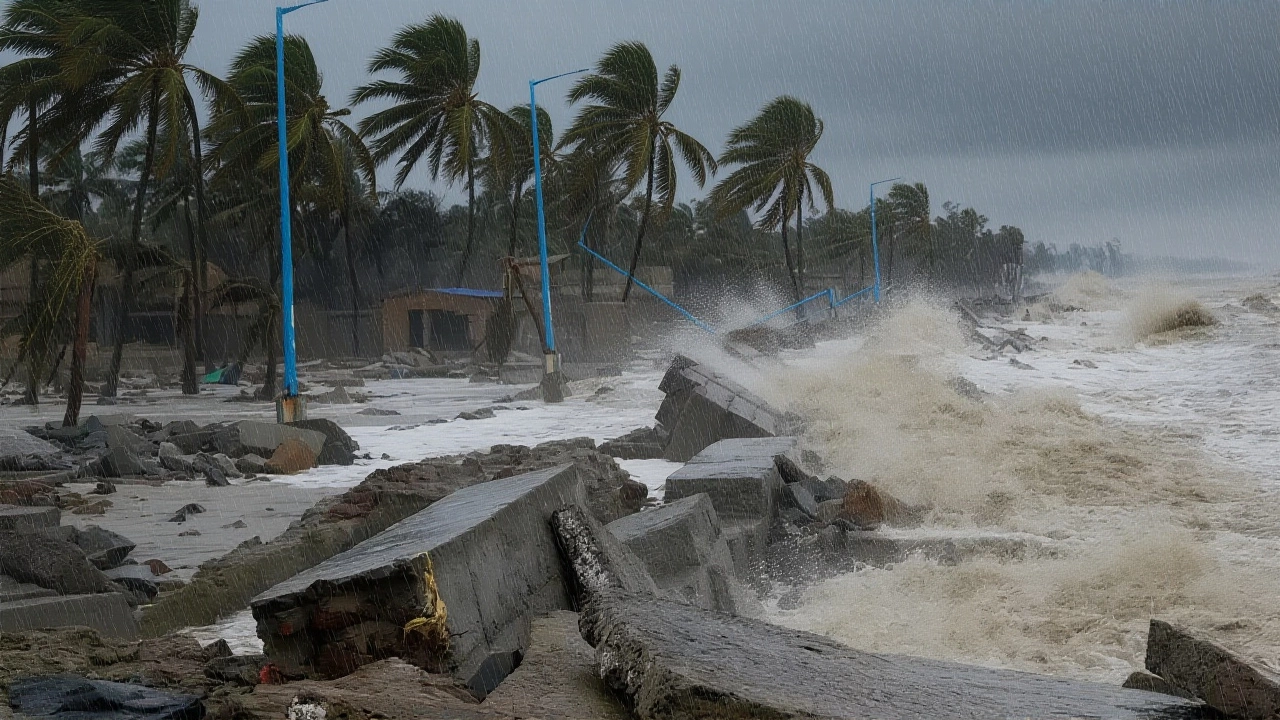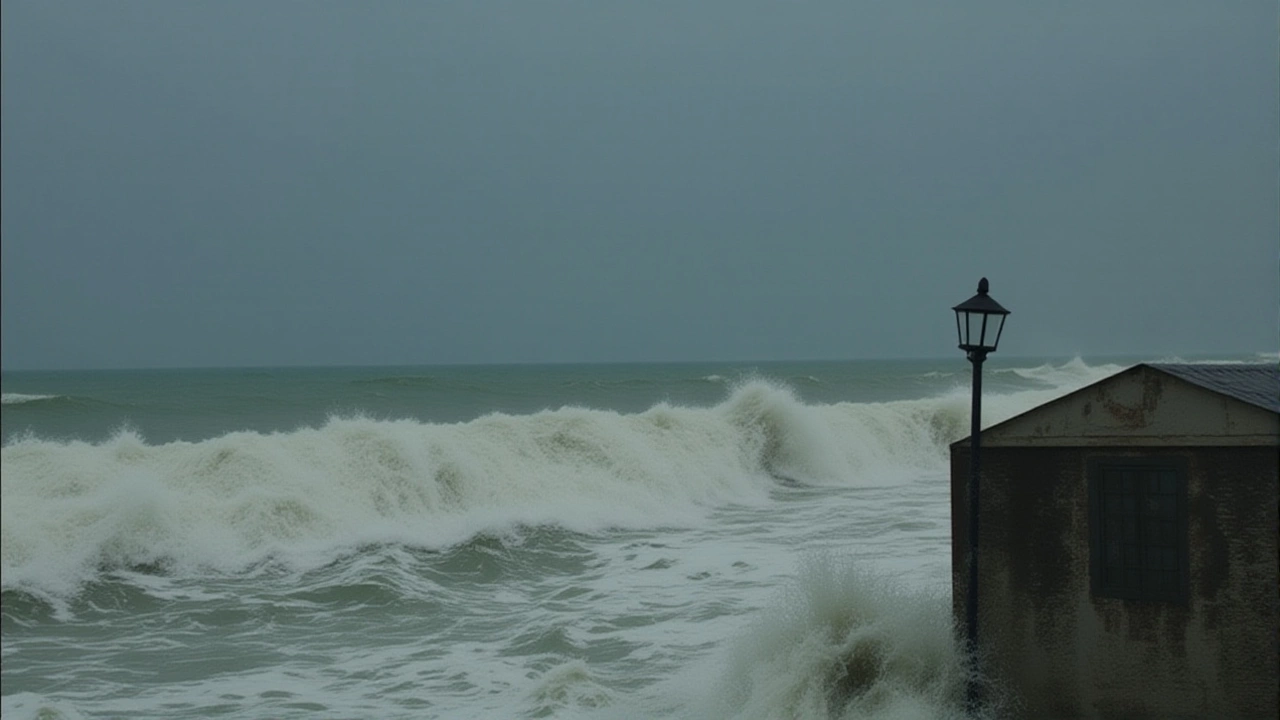The bodies of a young Indian family — a husband, wife, their two children, and three relatives — were pulled from the rubble of a mudslide in Tamil Nadu’s Tiruvannamalai district on Monday and Tuesday, turning a tragic storm into a national mourning. By Tuesday, December 5, 2024, the death toll from Cyclone Fengal had climbed to 28 across South Asia, with 17 dead in Sri Lanka and 11 in India, according to officials. The storm, which made landfall near the coast of Tamil Nadu on Saturday, December 2, 2024, dumped more rain in 24 hours than Puducherry had seen in three decades. But it was the quiet hillside village of Chidambaram Nagar where the human cost became most visceral — seven lives, erased in seconds by a wall of mud and rock.
The Family Lost in the Mud
On Sunday, December 3, 2024, heavy rains loosened the earth above the narrow road where Rajkumar, 30, and his wife, 24, lived with their two young children. Their relatives — three children of extended family — had come to visit. No one saw it coming. One moment, the sky was a gray curtain of rain; the next, the hillside collapsed. Emergency workers arrived within an hour, but the debris was thick — boulders the size of cars, saturated soil, twisted tree roots. For 12 hours, they dug by hand, using shovels and their bare fingers. Four bodies were recovered on Monday. The other three came out Tuesday morning. All seven were found huddled together, as if trying to shield the youngest.
Conflicting Reports, Rising Toll
For days, the numbers didn’t add up. On Saturday, K.K.S.S.R. Ramachandran, Tamil Nadu’s Minister for Revenue and Disaster Management, told reporters the death toll was just three — all from electrocution. "Damage," he said, "was minimal." But by Monday, as rescue teams reached remote villages, the picture changed. The state’s disaster agency confirmed seven more bodies from the Tiruvannamalai landslide alone. Then came the toll from Chennai: four dead. Ooty: one. Vellore: one. Puducherry: four. By Tuesday, MK Stalin, Chief Minister of Tamil Nadu, revised the state’s death toll to 12. "This wasn’t minimal," he said at a press conference. "This was a catastrophe that buried homes, schools, and hope."
ReliefWeb’s December 4 update confirmed 20 total fatalities in India — 16 in Tamil Nadu and four in Puducherry — while Sri Lanka’s disaster agency reported 17 dead. The final count of 28 emerged after Sri Lanka confirmed one additional fatality on Tuesday. The discrepancy wasn’t just bureaucratic. It was a symptom of how quickly disasters outpace reporting systems — especially in rural areas where roads are washed out and phone towers are down.
The Scale of Destruction
Behind the numbers were the ruins. MK Stalin said over 2,400 huts had been flattened. More than 200,000 hectares of farmland — rice paddies, banana groves, coconut plantations — were underwater. Nearly 1,000 cattle drowned. Bridges collapsed between villages. In some places, people walked for miles just to reach the nearest clinic. Schools remained closed for a second week. Emergency workers said they’d never seen flooding this widespread since Cyclone Gaja in 2018.
"We lost our entire crop season," said S. Meenakshi, a farmer from Kallakurichi, whose 12-acre field was now a swamp. "The government promised compensation. But how do you compensate for a year’s work gone in six hours?"

Climate Change and the New Normal
Scientists from the Indian Institute of Tropical Meteorology and the University of Madras say Cyclone Fengal fits a chilling pattern. Warmer waters in the Bay of Bengal — up to 2.5°C above average this year — mean more evaporation. More evaporation means more moisture in the air. More moisture means heavier rain. And as the atmosphere warms, storms hold that water longer, releasing it all at once.
"We’re not seeing more cyclones," said Dr. Arjun Mehta, a climate researcher at IIT Delhi. "We’re seeing more violent ones. Fengal had winds of 90 km/h — not record-breaking. But the rainfall? That’s the killer. It dropped 387 millimeters in 24 hours in Puducherry. That’s the highest since 1994."
Still, there’s a silver lining. In 1999, Cyclone Odisha killed over 10,000 people. In 2024, despite far worse rainfall, the death toll is under 30. Better forecasting. Faster evacuations. Stronger early-warning systems. "We’re learning," said Dr. Mehta. "But learning isn’t enough if the storms keep getting stronger."
What Comes Next
On Tuesday, MK Stalin appealed to Prime Minister Narendra Modi for 20 billion Indian rupees — $236 million — to rebuild homes, roads, and irrigation systems. "This isn’t charity," he said. "It’s recovery. And it’s urgent."
The weather bureau warned of more heavy rain through Thursday. In Sri Lanka, nearly 470,000 people remain in relief camps. In Tamil Nadu, volunteers are handing out bottled water and blankets. But the emotional toll? That’s harder to measure.
One rescue worker, who asked not to be named, said he found a child’s toy — a small plastic car — buried under the mud. "It was still intact," he said. "Like it was waiting."
Frequently Asked Questions
How did Cyclone Fengal compare to past storms in the Bay of Bengal?
Cyclone Fengal was not the strongest in wind speed — peaking at 90 km/h — but its rainfall was extreme, with Puducherry recording its highest 24-hour total in 30 years. In comparison, Cyclone Gaja (2018) killed 65 people in Tamil Nadu but dropped less rain. Fengal’s impact was amplified by saturated ground from earlier monsoon rains, turning mudslides into deadly traps.
Why were there conflicting death tolls from Indian officials?
Early reports from state ministers often rely on data from accessible urban centers, while rural landslide zones remain cut off for days. K.K.S.S.R. Ramachandran’s initial count of three deaths reflected only confirmed electrocution cases. The full toll emerged only after rescue teams reached remote areas like Tiruvannamalai, where communication and access were destroyed. This delay is common in fast-moving disasters.
What role did climate change play in Cyclone Fengal’s intensity?
Warmer sea surface temperatures in the Bay of Bengal — up to 2.5°C above average — allowed the cyclone to pull more moisture from the ocean, resulting in record rainfall. Studies show that for every 1°C of warming, the atmosphere holds 7% more water vapor. This doesn’t mean more cyclones, but more rain-heavy ones like Fengal, which overwhelm drainage systems and trigger landslides even with moderate winds.
How are survivors being supported in Tamil Nadu and Sri Lanka?
In Tamil Nadu, the state has opened 89 relief camps with food, clean water, and medical teams. In Sri Lanka, nearly 470,000 displaced people are in camps managed by the government and Red Cross. NGOs are distributing hygiene kits and temporary shelter tarps. But long-term housing and farmland restoration will require federal funding — which Tamil Nadu’s Chief Minister has requested at $236 million.
Why did the storm weaken so quickly after landfall?
Cyclone Fengal weakened rapidly because it moved over land — where friction and lack of warm ocean water starve the storm of energy. By Monday, December 4, it had dropped to a low-pressure system. But its damage was already done. The real danger isn’t always the wind — it’s the rain that falls before the storm even fades. That’s what flooded fields, triggered landslides, and buried families.
What’s the timeline for recovery in affected areas?
Clearing debris and restoring roads may take 3–6 weeks. But rebuilding homes and agricultural land could take over a year. The next monsoon season, expected in April 2025, will test whether new drainage systems can handle similar rainfall. Experts warn that without major infrastructure upgrades, even moderate storms could become disasters again.
